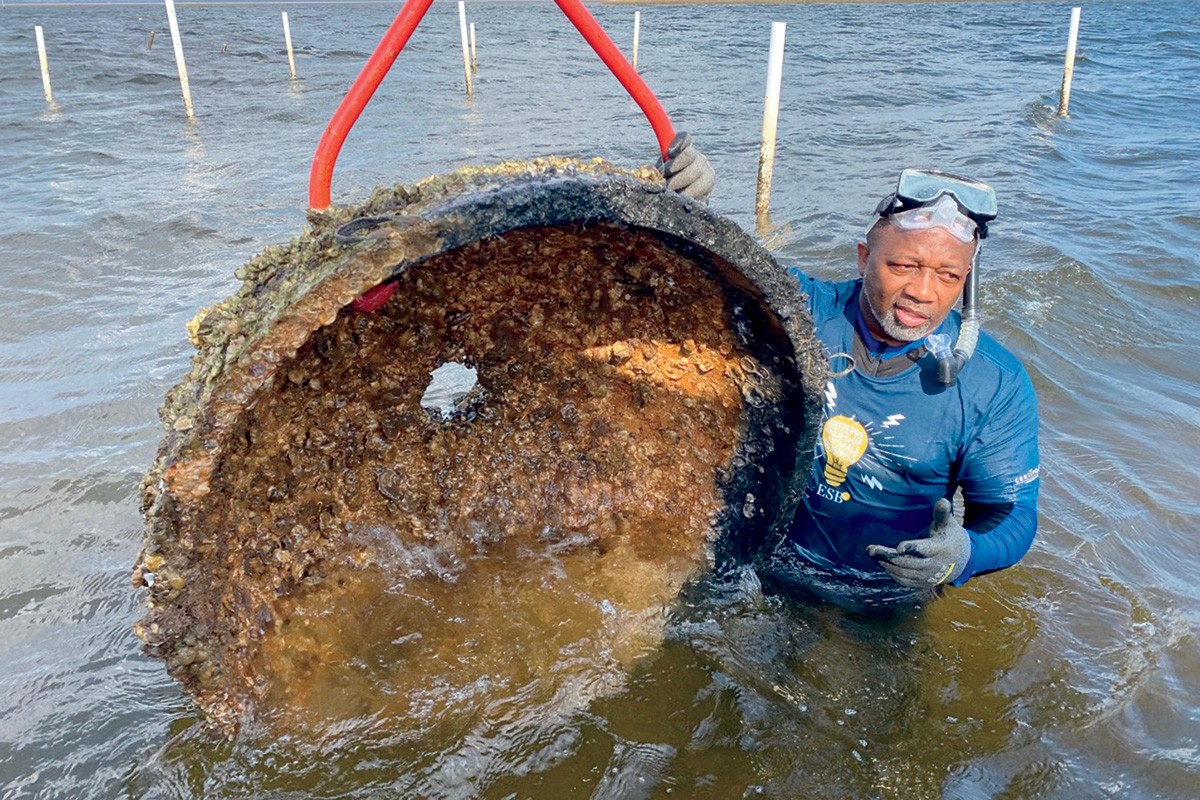SHARE:
Higher Education: Environment
Farm Team
With few oysters left on wild reefs, Southern states are tackling the challenges of farming them.
Nicolette Mariano, one of just three oyster farmers on Florida’s Atlantic Coast, says it’s by luck that she is hanging on in the risky business she loves. But like most farmers, she knows risk and luck are just part of the deal.
“Hurricane Ian saved us. We have more oysters than we know what to do with,” Mariano says of her nearly seven-acre lease in waters just south of the Sebastian Inlet in the Indian River Lagoon. But before Ian smashed Southwest Florida, crossed the state and eventually poured a silver lining of much-needed rain onto Mariano’s oysters, prospects looked grim.
“I was freaking out,” she says, explaining that drought during the summer of 2022 diminished the natural algae blooms that baby oysters need to thrive. Growing by the thousands in polyurethane, mesh bags suspended near the surface, they remained thumbnail-sized for more than six months, when they should have grown to an inch or two. High water temperatures also stressed the tiny creatures, which may have died if the rain-heavy hurricane had not flushed the lagoon with cooling freshwater and allowed the nutritional algae to grow.
Mariano lucked out, and now her Treasure Coast Shellfish business has nearly a million healthy oysters in the water close to ready for harvest. Still, her crop is not in the clear.
“I’m really worried about what’s going to happen in the next three months,” she said in mid-March. “They’ve been stressed their entire life. Will there be a big die-off?”
It happens, pretty often, and aquaculturists in Florida and other coastal Southern states are trying to learn why 50% to 90% of cultured oysters in some years succumb to disease and predators in late spring and early summer as they reach maturity.
Approximately 350 Southern scientists and oyster growers from the Carolinas to Texas gathered in Savannah, Ga., in March for this year’s Oyster South conference to confer about that, share research findings and trade practical observations.
Leslie Sturmer, a shellfish aquaculture extension specialist with the University of Florida/ IFAS Extension and Florida Sea Grant, is on the advisory board of Oyster South and has worked for decades in support of shellfisheries such as oysters and clams. Despite challenges that include unexplained oyster mortalities, shortage of seed, gear expense and risks related to hurricanes and tropical storms, Sturmer insists she is hopeful about building successful oyster farms, in part because of the rugged, risk-tolerant men and women drawn to working on the water.
“I am very much optimistic about this new industry,” says Sturmer, based at Sea Grant’s Cedar Key field office. “Every gulf university is invested in it.” The researchers are developing genetic lines of oysters that are more resistant to high and low salinity and disease in the Gulf of Mexico, and they are working with growers to evaluate these genetic lines under commercial conditions.
Oyster farming emerged because wild oysters are in decline — casualties of degraded water quality, disease, predation and, in some cases, unsustainable harvesting, not only around Florida and the Gulf of Mexico, but around the world, from Norway to Australia, with the latter working closely on oyster research with Sea Grant, a branch of the National Oceanic and Atmospheric Administration.
Florida’s iconic Apalachicola Bay — where people in skiffs long gathered wild oysters manually using fork-like tongs — is closed to oyster harvesting until 2025 following a series of catastrophes. Few Florida bays are healthy enough or clean enough to yield wild oysters for food, forcing shellfishers to turn to farming on state-approved lease sites.
There are 224 leases covering 451 acres of water column (submerged land and the water above) issued to 125 leaseholders culturing oysters, largely on Florida’s west and northwest coasts, according to the Florida Department of Agriculture’s division of aquaculture. More than 1,100 acres are leased to 210 leaseholders to grow clams. Each lease can cost thousands of dollars in fees, signage and set-up.
Four of the oyster farms are designated “sentinel” sites, where researchers and farmers are testing assorted gear and practices under various conditions and watching for causes of mortality. In general, the oysters are cultured in various configurations of rigid mesh bags, or sleeves, suspended by floats or cables. In some conditions, the cultured oysters can grow on bottom structures such as concrete domes or in mesh bags held just off the bottom on racks.
The sentinel sites are in Franklin County at Alligator Harbor and in Wakulla County at Oyster Bay. Wakulla Environmental Institute, a branch of Tallahassee Community College, is involved in the research; it is testing its own invention — oyster domes — and is teaching courses in oyster farming. The institute’s associate director, Al Wynn, says it is vital that scientists, regulators and aquaculture farmers figure out how to grow oysters again, and not just for people who like to eat them.
“Oysters are a keystone species, nature’s engineers,” Wynn says. “One adult oyster can filter 50 gallons of water a day. They can reduce red tide and algae blooms. The reefs are habitat for finfish and other marine life. We need all of that, but we’re losing it. We have to learn to live responsibly off our environment.”




























